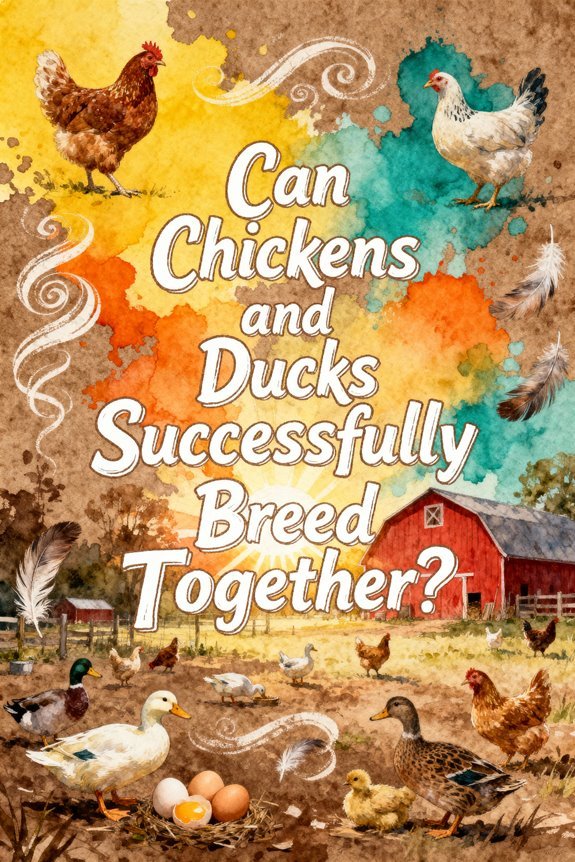Can Chickens and Ducks Successfully Breed Together?
No, chickens and ducks can’t successfully breed together due to their significant genetic incompatibilities. Your chickens have 39 chromosome pairs while ducks have 40, preventing viable hybrid embryo development. When attempted, fertilized eggs show extremely low fertility rates (5-25%) and typically fail during early embryonic stages due to mismatched gene expression. Genetic research confirms these insurmountable barriers, though understanding the science behind these limitations reveals fascinating insights about avian reproduction.
The Science Behind Interspecies Breeding
While the idea of breeding chickens and ducks may seem plausible given their similar appearances, the genetic barriers between these species make natural hybridization virtually impossible. Their distinct chromosome numbers and genetic makeup create insurmountable obstacles for hybrid viability, unlike more closely related species pairs such as horses and donkeys.
Even if physical mating occurs, their reproductive anatomy presents significant challenges. Female ducks have evolved complex vaginal structures that resist cross-species fertilization, while their distinct mating behaviors further reduce successful breeding chances. The genetic distance between these birds means that even if sperm reaches an egg, embryonic development would likely fail. You’ll find that without artificial laboratory intervention, such as germ cell manipulation, the biological barriers preventing chicken-duck hybrids remain firmly in place. However, scientists have successfully created viable offspring by injecting duck embryos with chicken germ cells that develop into reproductive material.
Common Myths About Duck-Chicken Hybrids
Despite persistent folklore surrounding duck-chicken hybrids, scientific evidence consistently refutes these claims through genetic, anatomical, and reproductive analysis. One of the most common hybrid misconceptions stems from observing mating behaviors between these species, but their significant genetic differences make viable offspring impossible. While ducks and chickens may display social bonding and attempted courtship, their distinct chromosome numbers and reproductive anatomies prevent successful fertilization.
You might notice these birds engaging in cross-species interactions, but don’t confuse this with breeding potential. Unlike successful hybrids such as mules or beefalo, which come from closely related species, ducks and chickens belong to entirely different families – Anatidae and Phasianidae respectively. Their genetic distance makes embryo development between the species biologically impossible. In fact, a drake mating with a chicken hen can be especially dangerous, as their aggressive behavior during mating can prove fatal to chickens.
Genetic Barriers Between Species
Because chickens and ducks possess fundamentally different genetic architectures, their reproductive isolation stems from multiple chromosomal incompatibilities. The significant genetic divergence between these species manifests in their distinct chromosome counts – chickens have 39 pairs while ducks have 40 pairs. These chromosomal differences create insurmountable barriers during meiosis, preventing viable hybrid embryo development.
You’ll find that even if fertilization occurs, the embryos typically arrest development early due to mismatched gene expression timing and incompatible sex chromosome systems. The few documented cases of distant avian hybrids, such as chicken-turkey crosses, demonstrate extremely low viability rates, particularly in males. This represents a classic example of cryptic biological invasion prevention through natural genetic barriers. When you consider the substantial genetic distance between chickens and ducks, successful hybridization becomes virtually impossible due to these fundamental genomic incompatibilities.
Behavioral Patterns When Housing Together
The distinct social dynamics between chickens and ducks create notable behavioral patterns when housed together. While sharing the same space, they maintain separate social structures, with chickens establishing their own flock hierarchy while ducks remain uninvolved in these pecking order dynamics. You’ll notice they naturally distance themselves, particularly during rest periods, as chickens seek elevated perches while ducks prefer ground-level areas. A minimum of 3 square feet per mature laying duck is essential for preventing stress and territorial disputes.
Housing success depends on proper space allocation and gender ratios. During breeding seasons, male presence can greatly disrupt flock harmony. Drakes may attempt harmful mating behaviors with chicken hens due to anatomical incompatibilities, while roosters might display territorial aggression. To maintain stability, you’ll need separate feeding stations, adequate ventilation to manage humidity from duck bathing areas, and sufficient space for natural species segregation.
Understanding Embryonic Development Challenges
While successful embryonic development presents complex challenges in any poultry breeding program, cross-species development between chickens and ducks faces particularly intricate obstacles. You’ll find that embryonic temperature requirements differ considerably between these species, with even slight deviations causing severe developmental abnormalities or mortality. Critical gas exchange processes through vitelline and allantoic circulation systems develop at species-specific rates, making hybrid embryo survival extremely difficult.
Research has shown that the critical development periods for thermal manipulation and organ formation vary significantly between chickens and ducks. The fundamental differences in organ development timing and extra-embryonic membrane formation create insurmountable barriers. When you examine the CO2 tolerance levels, you’ll notice that duck embryos can withstand higher concentrations during later stages, while chicken embryos show varying susceptibility based on their developmental phase. These physiological incompatibilities fundamentally prevent viable hybrid embryo formation between chickens and ducks.
Real-World Evidence and Research Findings
Recent advances in germline chimera research have revealed fascinating insights into chicken-duck cellular compatibility, despite their taxonomic distance. Studies show that chicken primordial germ cells can successfully colonize duck embryos, with transplanted tissue achieving 70-80% survival rates without immunosuppression. The research team demonstrated that duck’s disease immunity could be leveraged to protect and preserve rare chicken germplasm.
However, breeding success between chickens and ducks faces significant biological barriers. The genetic incompatibilities between Gallus and Anas genera typically result in non-viable or sterile offspring. While germ cell transplantation experiments demonstrate promising cellular integration, you’ll find that fundamental differences in leg morphology, growth rates, and physiological systems present substantial obstacles. These findings raise ethical implications for conservation efforts, suggesting that while germline chimera technology offers potential for biobanking endangered species, natural hybridization between chickens and ducks remains highly improbable.
Practical Considerations for Backyard Farmers
Successful backyard farming with mixed poultry flocks requires meticulous attention to species-specific housing, nutrition, and behavioral requirements. You’ll need separate resting areas – elevated roosts for chickens and ground-level spots for ducks – with at least 4 square feet per bird in the coop and 10 square feet in the run. While communal feeding might seem convenient, establish species-specific feeding stations to guarantee proper nutrition, especially since ducks require higher niacin levels. Although breeding preferences differ between species, remember that ducks and chickens cannot produce viable hybrid offspring due to genetic incompatibility. To maintain flock harmony, provide separate water sources to accommodate ducks’ dabbling behavior while keeping chickens’ areas dry, and monitor social dynamics closely to prevent inter-species aggression. For optimal comfort, ensure the coop has proper ventilation to manage the increased moisture from duck droppings.
Health and Viability Concerns
Beyond the basic logistics of mixed-species housing, you’ll need to understand the stark biological realities of chicken-duck crossbreeding attempts. The scientific evidence shows extremely low fertility rates of 5-25% in interspecies poultry crosses, with most fertilized eggs failing during early embryonic development. Hybrid health issues are severe and widespread, as genetic incompatibilities between chickens and ducks create significant barriers to embryo viability. When rare fertilization does occur, up to 70% of embryos experience developmental arrest during critical stages like blood island formation. Even in the extremely unlikely event of successful hatching, any surviving hybrids would face serious health challenges including arthritis, heart problems, and severely reduced lifespan. Current research provides no evidence of viable chicken-duck hybrids ever being produced. This is consistent with evolutionary findings showing that reproductive isolation naturally develops between species to prevent unsuccessful hybridization attempts.
Best Practices for Mixed Poultry Housing
Three fundamental principles guide effective mixed poultry housing design: structural integrity, species-specific accommodation, and environmental control. When implementing these housing considerations, you’ll need to construct well-ventilated shelters on elevated, well-drained ground, oriented southward or eastward for ideal sunlight exposure. Install predator-proof mesh underground around enclosure perimeters to prevent coyotes from accessing your birds through tunneling. Consider planting aromatic herbs like rosemary and lavender around the housing perimeter to naturally deter birds from wandering.
Space allocation must account for each species’ distinct requirements. You’ll need 1.5 square feet per chicken and 3 square feet per duck indoors, with considerably larger outdoor areas of 8 and 15 square feet respectively. Maintain stock density limits to prevent overcrowding and ensure bird comfort in group settings. Utilize hybrid flooring systems combining deep litter for natural behavior with slatted sections near feeding areas. Install adjustable ventilation inlets angled upward to maintain proper air circulation while preventing drafts. Incorporate secure barriers against predators, including mesh covers for outdoor spaces and robust locking mechanisms on all access points.



